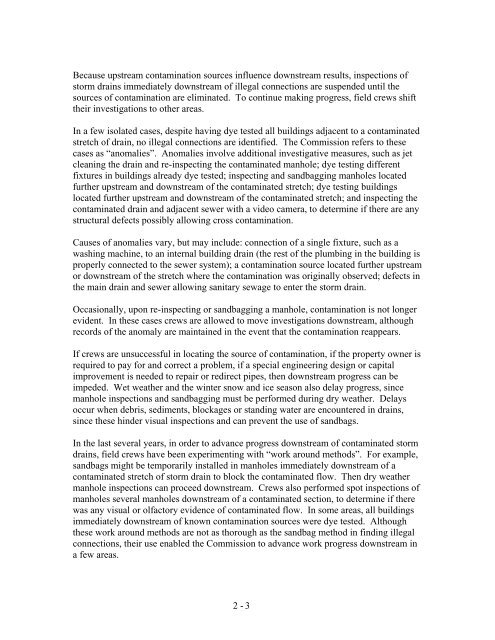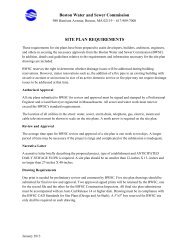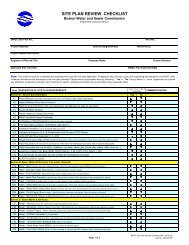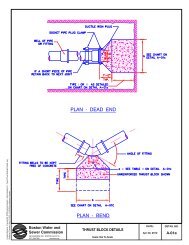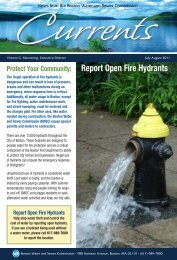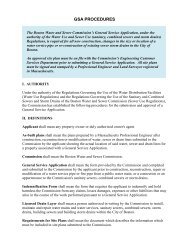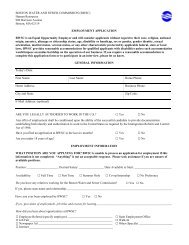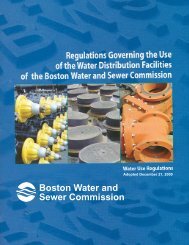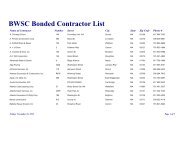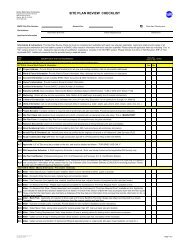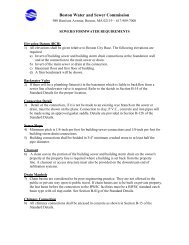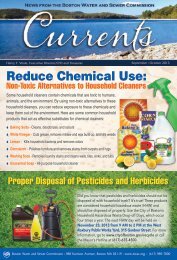2010 Stormwater Management Report (PDF) - US Environmental ...
2010 Stormwater Management Report (PDF) - US Environmental ...
2010 Stormwater Management Report (PDF) - US Environmental ...
You also want an ePaper? Increase the reach of your titles
YUMPU automatically turns print PDFs into web optimized ePapers that Google loves.
Because upstream contamination sources influence downstream results, inspections of<br />
storm drains immediately downstream of illegal connections are suspended until the<br />
sources of contamination are eliminated. To continue making progress, field crews shift<br />
their investigations to other areas.<br />
In a few isolated cases, despite having dye tested all buildings adjacent to a contaminated<br />
stretch of drain, no illegal connections are identified. The Commission refers to these<br />
cases as “anomalies”. Anomalies involve additional investigative measures, such as jet<br />
cleaning the drain and re-inspecting the contaminated manhole; dye testing different<br />
fixtures in buildings already dye tested; inspecting and sandbagging manholes located<br />
further upstream and downstream of the contaminated stretch; dye testing buildings<br />
located further upstream and downstream of the contaminated stretch; and inspecting the<br />
contaminated drain and adjacent sewer with a video camera, to determine if there are any<br />
structural defects possibly allowing cross contamination.<br />
Causes of anomalies vary, but may include: connection of a single fixture, such as a<br />
washing machine, to an internal building drain (the rest of the plumbing in the building is<br />
properly connected to the sewer system); a contamination source located further upstream<br />
or downstream of the stretch where the contamination was originally observed; defects in<br />
the main drain and sewer allowing sanitary sewage to enter the storm drain.<br />
Occasionally, upon re-inspecting or sandbagging a manhole, contamination is not longer<br />
evident. In these cases crews are allowed to move investigations downstream, although<br />
records of the anomaly are maintained in the event that the contamination reappears.<br />
If crews are unsuccessful in locating the source of contamination, if the property owner is<br />
required to pay for and correct a problem, if a special engineering design or capital<br />
improvement is needed to repair or redirect pipes, then downstream progress can be<br />
impeded. Wet weather and the winter snow and ice season also delay progress, since<br />
manhole inspections and sandbagging must be performed during dry weather. Delays<br />
occur when debris, sediments, blockages or standing water are encountered in drains,<br />
since these hinder visual inspections and can prevent the use of sandbags.<br />
In the last several years, in order to advance progress downstream of contaminated storm<br />
drains, field crews have been experimenting with “work around methods”. For example,<br />
sandbags might be temporarily installed in manholes immediately downstream of a<br />
contaminated stretch of storm drain to block the contaminated flow. Then dry weather<br />
manhole inspections can proceed downstream. Crews also performed spot inspections of<br />
manholes several manholes downstream of a contaminated section, to determine if there<br />
was any visual or olfactory evidence of contaminated flow. In some areas, all buildings<br />
immediately downstream of known contamination sources were dye tested. Although<br />
these work around methods are not as thorough as the sandbag method in finding illegal<br />
connections, their use enabled the Commission to advance work progress downstream in<br />
a few areas.<br />
2 - 3


